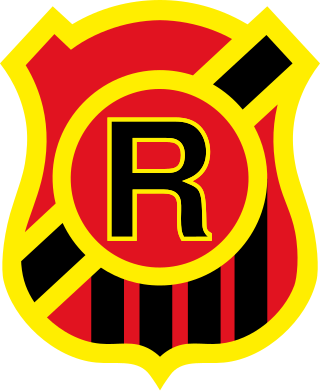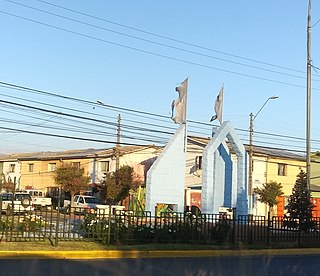Related Research Articles

The LVI Legislature of the Congress of Mexico met from 1994 to 1997.

Estadio Víctor Jara is an indoor multi-use sports complex located in the western part of Santiago, Chile, near the Estación Central and Alameda Avenue. It has a total capacity for an audience of 6,500 people.

Curicó Unido is a football club based in Curicó, Maule Region, Chile. They currently play in the Primera División, the first level of the Chilean football system. They are currently managed by Damián Muñoz.

Club Social de Deportes Rangers is a Chilean football club based in the city of Talca. The club was founded November 2, 1902 and plays in the second level of the Chilean football system. Their home games are played at the Fiscal stadium, which has a capacity of 16,000 seats.

Canto libre is the fifth studio album by Chilean singer-songwriter Víctor Jara, released in 1970 by Odeon. In this album, he had the support of Inti-Illimani and Patricio Castillo.

Volcán Tupungatito is the northernmost historically active stratovolcano of the southern Andes. Part of the Chilean Andes' volcanic segment, it is the northernmost member of the Southern Volcanic Zone (SVZ), which is one of several distinct volcanic belts in the Andes. Over 70 Pleistocene or Holocene age volcanoes make up this volcanic belt, which on average has one eruption per year.

El Quisco is a Chilean city and commune in San Antonio Province, Valparaíso Region. Located in the country's central coast, it serves as a popular summer resort for the population of Santiago and forms part of the Coast of Poets, a cultural space named after four world-renowned Chilean poets: Pablo Neruda, Vicente Huidobro, Violeta Parra and Nicanor Parra. El Quisco is home to La Casa de Isla Negra, the former house of Chilean poet Pablo Neruda, which is now a museum and Neruda's burial site.

Los Ángeles Negros are a Chilean pop ballad band formed in San Carlos de Chile in 1968. The band's best-known line-up consisted of singer Germaín de la Fuente, guitarist Mario Gutiérrez, keyboardist Jorge González, bassist Miguel Ángel "Nano" Concha, and drummer Luis Ortiz. Their music is a blend of boleros, psychedelic funk and rock music, known as Balada rockmántica.
María Isabel is a Mexican telenovela produced by Carla Estrada for Televisa. It aired on Canal de las Estrellas from August 4, 1997 to February 6, 1998. María Isabel, is one of the few telenovelas that focuses on the life of an indigenous female protagonist and her community. The story was written by Yolanda Vargas Dulché and adapted by René Muñoz.

A tembetá or barbote (Argentina) is a metal or stone rod placed in lower lip piercings by members of some indigenous peoples in South America. It has been used since the Neolithic period by different human groups for body modification, spiritual protection, and indication of sexual maturity.

Isla de Maipo is a town and commune of the Talagante Province in central Chile's Santiago Metropolitan Region.

Dawson Isla 10 is a 2009 Chilean drama film, written and directed by Miguel Littín, a Chilean film director. The screenplay is based on Isla 10, a book by Sergio Bitar about his experiences as a political prisoner; "Isla 10" was the substitute name their guards imposed him during his imprisonment.

The Tomé Tragedy was the worst fans bus disaster in the history of Chilean football. The tragedy affected the O'Higgins fans after a 2013 Torneo Transición match versus Huachipato in Talcahuano, where in the Cuesta Caracol, the bus fell into a ravine about 100 meters. A bus of the public transport of Rancagua Trans O'Higgins was the vehicle that suffered the accident.
The following lists events that happened during 1978 in Chile.

Si yo fuera rico is a Chilean telenovela written by Rodrigo Cuevas, that premiered on Mega on January 8, 2018 and ended on October 2, 2018. It stars Jorge Zabaleta, Mariana Loyola, Gonzalo Valenzuela, María Gracia Omegna, Daniel Muñoz and Simón Pesutic.
Juana Brava is a Chilean television series created by Ignacio Arnold and Nimrod Amitai and produced and aired by Televisión Nacional de Chile (TVN) during the second half of 2015. The series takes place in the fictional town of San Fermín, inspired by the Chilean town of Tiltil, and focuses on the abuse of power and the struggle of a simple woman to change a complex system dominated by large and powerful entities. It highlights conflicts between citizens, social problems, corruption, and the struggle for rights.

Miss Grand Costa Rica is a San José-based female national beauty pageant in Costa Rica, organized separately for in first time in 2022 by the Concurso Nacional de Belleza de Costa Rica, with Erick Solis as the president. The winner of the contest represents the country at its parent competition, the Miss Grand International pageant. Before 2022, the competition license belonged to different organizers, such as the Reinas de Costa Rica organization (2015 – 2017) and the Miss Costa Rica organization (2018 – 2021). Most of the country's representatives at the Miss Grand International pageant during such a period were appointed without organizing the respective pageant.
References
- ↑ "Bato and Llolleo cultures". Archived from the original on 2007-12-12. Retrieved 2009-12-04.
- ↑ "The ovens of Lonquén". Landmark events. Derechos Chile. 2002. Retrieved 2009-12-04.
- ↑ "Francesca Ancarola - Lonquén: Tribute to Víctor Jara". Reviews. RootsWorld. 2007. Retrieved 2009-12-04.
- ↑ Estrada, Daniela. "Chile: Study Shows How Leading Paper Colluded with Dictatorship". Reports from Australia and around the World. Online Media. Archived from the original on 2012-03-05. Retrieved 2009-12-04.[ permanent dead link ]
- ↑ "La Nacion: Identifican a trece víctimas halladas en Hornos de Lonquén". La Nacion. 2010. Archived from the original on 2010-02-21.
- ↑ No olvidar. Ignacio Agüero. 1982.